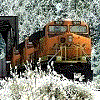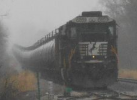Adding Quill to Locomotive?
Adding Quill to Locomotive?
Is there a way to somehow add a quill to a locomotive? (Like putting one on the Pacific Surfliner Cabcar) (The "N" key)
**Not taking any requests**
Santa Fe All The Way
Nothing Runs Like a Deere
No Farms No Food
Ford Powerstroke
My 87 Ford: https://www.youtube.com/channel/UCvNRba ... _tNs53k42w
Santa Fe All The Way
Nothing Runs Like a Deere
No Farms No Food
Ford Powerstroke
My 87 Ford: https://www.youtube.com/channel/UCvNRba ... _tNs53k42w
-

ET44C4 - Posts: 3187
- Joined: Mon Aug 22, 2016 12:01 pm
- Location: Clover, South Carolina
Re: Adding Quill to Locomotive?
Yes, it has been done by many people. Even I have yet to find how how one adds the horn quill feature onto another engine.

Anthony Nguyen
Youtube: https://www.youtube.com/fastfreightstudios
GeForce RTX 3050Ti Mobile, AMD Ryzen 7 5800H, 16GB RAM, 3TB Storage
It's January. So long...
-

ZekTheKid - Posts: 2430
- Joined: Mon Dec 29, 2014 6:05 pm
- Location: Cumberland, MD
Re: Adding Quill to Locomotive?
There is no other way than scripting and different tonalities of sounds.
Intel i7-7900K (3.60 GHz) - ASUS Prime Z390A - 32 GB DDR4 RAM 2400 MHz
GPU EVGA GTX-1060 OC 6GB at 1920x1080, 144 Hz - Monitor ASUS VG-248QE
System Windows 11 Pro in WD SSD 500 GB. Games in Inland 1Tb M.2 NVMe PCIe
GPU EVGA GTX-1060 OC 6GB at 1920x1080, 144 Hz - Monitor ASUS VG-248QE
System Windows 11 Pro in WD SSD 500 GB. Games in Inland 1Tb M.2 NVMe PCIe
-

jalsina - Posts: 2015
- Joined: Sun Jul 05, 2015 8:32 pm
Re: Adding Quill to Locomotive?
jalsina wrote:There is no other way than scripting and different tonalities of sounds.
It can actually be done without any scripting and without changing any of the sound samples. All you need is to be able to edit bin files.
You add a new control value to the engine's blueprint (bin file) - you could, for example, call it "Quill". Give it a value range of 0..1 and make its interface element be an "Interior lever". In the loco's inputmapper, bind that control to a suitable key so that pressing the key causes the control value to start increasing and releasing the key causes the value to start decreasing. In the engine's sound blueprint (proxybin), set up a pitch modifier for the horn (or whistle) , where the pitch is governed by the value of "Quill", using a curve that causes the pitch to drop about 0.2 as "Quill" rises from 0 to 1.
-

mrennie - Posts: 3214
- Joined: Wed May 30, 2012 12:22 pm
Re: Adding Quill to Locomotive?
mrennie wrote:jalsina wrote:There is no other way than scripting and different tonalities of sounds.
It can actually be done without any scripting and without changing any of the sound samples. All you need is to be able to edit bin files.
You add a new control value to the engine's blueprint (bin file) - you could, for example, call it "Quill". Give it a value range of 0..1 and make its interface element be an "Interior lever". In the loco's inputmapper, bind that control to a suitable key so that pressing the key causes the control value to start increasing and releasing the key causes the value to start decreasing. In the engine's sound blueprint (proxybin), set up a pitch modifier for the horn (or whistle) , where the pitch is governed by the value of "Quill", using a curve that causes the pitch to drop about 0.2 as "Quill" rises from 0 to 1.
Okay thanks for the information.
**Not taking any requests**
Santa Fe All The Way
Nothing Runs Like a Deere
No Farms No Food
Ford Powerstroke
My 87 Ford: https://www.youtube.com/channel/UCvNRba ... _tNs53k42w
Santa Fe All The Way
Nothing Runs Like a Deere
No Farms No Food
Ford Powerstroke
My 87 Ford: https://www.youtube.com/channel/UCvNRba ... _tNs53k42w
-

ET44C4 - Posts: 3187
- Joined: Mon Aug 22, 2016 12:01 pm
- Location: Clover, South Carolina
Re: Adding Quill to Locomotive?
mrennie wrote:jalsina wrote:There is no other way than scripting and different tonalities of sounds.
It can actually be done without any scripting and without changing any of the sound samples. All you need is to be able to edit bin files.
You add a new control value to the engine's blueprint (bin file) - you could, for example, call it "Quill". Give it a value range of 0..1 and make its interface element be an "Interior lever". In the loco's inputmapper, bind that control to a suitable key so that pressing the key causes the control value to start increasing and releasing the key causes the value to start decreasing. In the engine's sound blueprint (proxybin), set up a pitch modifier for the horn (or whistle) , where the pitch is governed by the value of "Quill", using a curve that causes the pitch to drop about 0.2 as "Quill" rises from 0 to 1.
Is there an example of this in some DLC out there?
Intel i7-7900K (3.60 GHz) - ASUS Prime Z390A - 32 GB DDR4 RAM 2400 MHz
GPU EVGA GTX-1060 OC 6GB at 1920x1080, 144 Hz - Monitor ASUS VG-248QE
System Windows 11 Pro in WD SSD 500 GB. Games in Inland 1Tb M.2 NVMe PCIe
GPU EVGA GTX-1060 OC 6GB at 1920x1080, 144 Hz - Monitor ASUS VG-248QE
System Windows 11 Pro in WD SSD 500 GB. Games in Inland 1Tb M.2 NVMe PCIe
-

jalsina - Posts: 2015
- Joined: Sun Jul 05, 2015 8:32 pm
Re: Adding Quill to Locomotive?
I had a quill but then I ran out of ink. 



Buzz
39 and holding.
"Some people find fault like there's a reward for it."- Zig Ziglar
"If you can dream it you can do it."- Walt Disney

39 and holding.
"Some people find fault like there's a reward for it."- Zig Ziglar
"If you can dream it you can do it."- Walt Disney

-

buzz456 - Site Admin
- Posts: 21020
- Joined: Sun Mar 21, 2010 8:30 am
- Location: SW Florida
Re: Adding Quill to Locomotive?
buzz456 wrote:I had a quill but then I ran out of ink.
Buzz please

What even is a quill anyways?
sreehC,
Jack
goddrauG backwards is Guarddog.
Jack
goddrauG backwards is Guarddog.
-

goddrauG - Posts: 512
- Joined: Fri May 27, 2016 4:10 pm
- Location: New Hampshire, United States
Re: Adding Quill to Locomotive?
"it was fun to hear the engineers "quilling" their horns by slowly pulling on the horn handle and going through the metering step. The horn would take on quite a different sound at a considerably lower sound pressure level. I'm sure the residents along the line appreciated the clever quilling work of a skilled engineer.
There were 2 manufactures, Viloco and Graham White. The Viloco (no longer available) was the easiest to work through the metered portion of the valve.
The still available Graham White 353 manual valve: http://www.grahamwhite.com/main/product ... &P2=-1
EMD now uses this valve: http://www.grahamwhite.com/main/product ... &P2=-1
And GE, this valve: http://www.grahamwhite.com/main/product ... &P2=-1"
There were 2 manufactures, Viloco and Graham White. The Viloco (no longer available) was the easiest to work through the metered portion of the valve.
The still available Graham White 353 manual valve: http://www.grahamwhite.com/main/product ... &P2=-1
EMD now uses this valve: http://www.grahamwhite.com/main/product ... &P2=-1
And GE, this valve: http://www.grahamwhite.com/main/product ... &P2=-1"
Buzz
39 and holding.
"Some people find fault like there's a reward for it."- Zig Ziglar
"If you can dream it you can do it."- Walt Disney

39 and holding.
"Some people find fault like there's a reward for it."- Zig Ziglar
"If you can dream it you can do it."- Walt Disney

-

buzz456 - Site Admin
- Posts: 21020
- Joined: Sun Mar 21, 2010 8:30 am
- Location: SW Florida
Re: Adding Quill to Locomotive?
jalsina wrote:mrennie wrote:jalsina wrote:There is no other way than scripting and different tonalities of sounds.
It can actually be done without any scripting and without changing any of the sound samples. All you need is to be able to edit bin files.
You add a new control value to the engine's blueprint (bin file) - you could, for example, call it "Quill". ....
Is there an example of this in Some DLC out there?
Both of my locos (FEF-3 and the AT&N Consolidation) use this technique.
-

mrennie - Posts: 3214
- Joined: Wed May 30, 2012 12:22 pm
Re: Adding Quill to Locomotive?
The F59PHI from the Pacific Surfliner route has a quill feaature using the 'n' key.

Anthony Nguyen
Youtube: https://www.youtube.com/fastfreightstudios
GeForce RTX 3050Ti Mobile, AMD Ryzen 7 5800H, 16GB RAM, 3TB Storage
It's January. So long...
-

ZekTheKid - Posts: 2430
- Joined: Mon Dec 29, 2014 6:05 pm
- Location: Cumberland, MD
Re: Adding Quill to Locomotive?
ZekTheKid wrote:The F59PHI from the Pacific Surfliner route has a quill feaature using the 'n' key.
Also the cabcar included with the Coaster add-on.
**Not taking any requests**
Santa Fe All The Way
Nothing Runs Like a Deere
No Farms No Food
Ford Powerstroke
My 87 Ford: https://www.youtube.com/channel/UCvNRba ... _tNs53k42w
Santa Fe All The Way
Nothing Runs Like a Deere
No Farms No Food
Ford Powerstroke
My 87 Ford: https://www.youtube.com/channel/UCvNRba ... _tNs53k42w
-

ET44C4 - Posts: 3187
- Joined: Mon Aug 22, 2016 12:01 pm
- Location: Clover, South Carolina
Re: Adding Quill to Locomotive?
mrennie wrote:jalsina wrote:There is no other way than scripting and different tonalities of sounds.
It can actually be done without any scripting and without changing any of the sound samples. All you need is to be able to edit bin files.
You add a new control value to the engine's blueprint (bin file) - you could, for example, call it "Quill". Give it a value range of 0..1 and make its interface element be an "Interior lever". In the loco's inputmapper, bind that control to a suitable key so that pressing the key causes the control value to start increasing and releasing the key causes the value to start decreasing. In the engine's sound blueprint (proxybin), set up a pitch modifier for the horn (or whistle) , where the pitch is governed by the value of "Quill", using a curve that causes the pitch to drop about 0.2 as "Quill" rises from 0 to 1.
Would there perhaps be a video out there explaining how to do this?
**Not taking any requests**
Santa Fe All The Way
Nothing Runs Like a Deere
No Farms No Food
Ford Powerstroke
My 87 Ford: https://www.youtube.com/channel/UCvNRba ... _tNs53k42w
Santa Fe All The Way
Nothing Runs Like a Deere
No Farms No Food
Ford Powerstroke
My 87 Ford: https://www.youtube.com/channel/UCvNRba ... _tNs53k42w
-

ET44C4 - Posts: 3187
- Joined: Mon Aug 22, 2016 12:01 pm
- Location: Clover, South Carolina
Re: Adding Quill to Locomotive?
ET44C4 wrote:mrennie wrote:jalsina wrote:There is no other way than scripting and different tonalities of sounds.
It can actually be done without any scripting and without changing any of the sound samples. All you need is to be able to edit bin files.
You add a new control value to the engine's blueprint (bin file) - you could, for example, call it "Quill". Give it a value range of 0..1 and make its interface element be an "Interior lever". In the loco's inputmapper, bind that control to a suitable key so that pressing the key causes the control value to start increasing and releasing the key causes the value to start decreasing. In the engine's sound blueprint (proxybin), set up a pitch modifier for the horn (or whistle) , where the pitch is governed by the value of "Quill", using a curve that causes the pitch to drop about 0.2 as "Quill" rises from 0 to 1.
Would there perhaps be a video out there explaining how to do this?
There is not. Why don't you try the sometimes thought to be obsolete method of reading.
Buzz
39 and holding.
"Some people find fault like there's a reward for it."- Zig Ziglar
"If you can dream it you can do it."- Walt Disney

39 and holding.
"Some people find fault like there's a reward for it."- Zig Ziglar
"If you can dream it you can do it."- Walt Disney

-

buzz456 - Site Admin
- Posts: 21020
- Joined: Sun Mar 21, 2010 8:30 am
- Location: SW Florida
Re: Adding Quill to Locomotive?
Everybody takes in info in their own way. Visual with images and the work being shown or written down. But yeah, if there aren't vids, go for the written version.
sreehC,
Jack
goddrauG backwards is Guarddog.
Jack
goddrauG backwards is Guarddog.
-

goddrauG - Posts: 512
- Joined: Fri May 27, 2016 4:10 pm
- Location: New Hampshire, United States
26 posts
• Page 1 of 2 • 1, 2
Who is online
Users browsing this forum: No registered users and 3 guests
